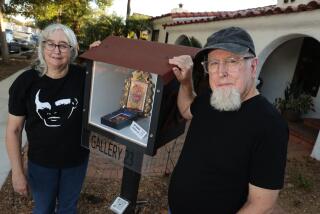ART REVIEW : StreetSites Art Displays Aren’t Much
- Share via
SAN DIEGO — This year, for the first time in the program’s six-year history, Sushi’s StreetSites projects can be found all over San Diego, not just in the center of the city. This year, Sushi made special efforts to encourage artists without public art backgrounds to participate in the monthlong show of publicly sited works.
Also this year, for the first time in recent memory, the results are uniformly disastrous.
Sushi’s new strategies widen the scope of the program in terms of both artists and audience, but the projects themselves are so short on appeal that the efforts seem to have been wasted. Across the board, the works are weak conceptually and often even weaker aesthetically.
Of the five projects, Michael Golino and Nina Karavasiles’ collaborative “A Where-ness Piece” comes closest to visual poetry, but its inappropriate siting renders its message wholly ineffectual. The work demands time, deliberation and close inspection, but it is installed in a field by a road with no sidewalk and absolutely no natural foot traffic.
Located near Brown Field, just a few miles from the Otay Mesa border crossing, the work attempts to address the rich political and cultural dimensions of the border region. Words and phrases stenciled onto both sides of magenta metal flags, mounted on steel poles and aligned in a circle, often propose conditions and contradictions that relate to the meeting of these two vastly different nations. Colonized/democratized , alienation/naturalization , destination/immigration are among the few word pairs to have resonance with border issues, but none possess any particular eloquence on the subject.
Sam Frazier’s “American Dream” suffers from the same sorry combination of illegibility when viewed from the road, and poor siting in an area with minimal foot traffic--this one is at the intersection of 40th Street and Orange Avenue.
Twelve of Frazier’s collage and assemblage panels hang along the inside of a chain-link fence that encloses an empty lot. Images of rainbows, lunar landscapes and residential scenes in decay are each accompanied by a single stenciled word, such as access , identity , constructs , margin and memory .
Though these are popular buzzwords in today’s politicized art world, on the street they feel unnecessarily obtuse and pretentious. Frazier’s concept and his execution are both embarrassingly shoddy.
Roberto Salas’ “Tribute to Icarus” and Pamela Underwood’s “Avant Guard Dogs” both aspire to comment on the fundamental nature or function of their sites, but manage only to add superficial layers of decoration to them. Salas punctuated the exterior, corrugated metal walls of an airplane hangar (No. 120 at Montgomery Field) with oversize paintings of birds. Underwood mounted a painted panel showing a row of German shepherds onto the facade of Sushi’s downtown space (852 8th Ave.) to suggest the threatening presence of Mexican guard dogs. Here, the dogs look more like mascots than menaces, and both projects appear especially gratuitous.
The installations and performances of Peter Phillips’ “Neighborhood” are intended to change over the course of the show. On one recent visit, the Community Concourse (202 C St.) site held an oversize, torn movie theater ticket made of cardboard and a pair of large cardboard dominoes. An anecdote written on the reverse of one of the dominoes describes a funeral the artist attended as a child, and the memory of adults commanding the kids to be quiet and to stop throwing dominoes during the service. This small effort at evoking intimacy through a casually shared memory feels earnest, but, again, ineffectual, as it easily gets lost in the sprawling, anonymous public plaza.
Five proposals that garnered honorable mentions can also be seen in Sushi’s gallery space this month, but these too tend to be both simple and simplistic.
Next year’s StreetSites program calls for a dramatically different strategy.
StreetSites, at Sushi Gallery, 852 8th Ave., and sites throughout San Diego, through April 6.
More to Read
The biggest entertainment stories
Get our big stories about Hollywood, film, television, music, arts, culture and more right in your inbox as soon as they publish.
You may occasionally receive promotional content from the Los Angeles Times.










